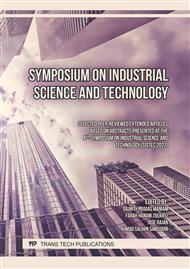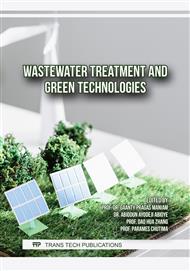[1]
J. Wall, J. Van Gerpen, and J. Thompson, "Soap and Glycerin Removal from Biodiesel Using Waterless Processes," Trans. ASABE, vol. 54, no. 2, p.535–541, 2011.
DOI: 10.13031/2013.36456
Google Scholar
[2]
A. Aguirre, S. Peiru, F. Eberhardt, L. Vetcher, R. Cabrera, and H. G. Menzella, "Enzymatic hydrolysis of steryl glucosides, major contaminants of vegetable oil-derived biodiesel," Appl. Microbiol. Biotechnol., vol. 98, no. 9, p.4033–4040, May 2014.
DOI: 10.1007/s00253-013-5345-4
Google Scholar
[3]
P. M. Nielsen, J. Brask, and L. Fjerbaek, "Enzymatic biodiesel production: Technical and economical considerations," Eur. J. Lipid Sci. Technol., vol. 110, no. 8, p.692–700, Aug. 2008.
DOI: 10.1002/ejlt.200800064
Google Scholar
[4]
M. F. Danzer, "Biodiesel cold filtration process." United State Patent, Aug. 02, 2007.
Google Scholar
[5]
C. Boshui, S. Yuqiu, F. Jianhua, W. Jiu, and W. Jiang, "Effect of cold flow improvers on flow properties of soybean biodiesel," Biomass Bioenergy, vol. 34, no. 9, p.1309–1313, Sep. 2010.
DOI: 10.1016/j.biombioe.2010.04.001
Google Scholar
[6]
N. Isioma, Y. Muhammad, O. Sylvester, D. Innocent, and O. Linus, "Cold Flow Properties and Kinematic Viscosity of Biodiesel," Univers. J. Chem., vol. 1, no. 4, p.135–141, Dec. 2013.
DOI: 10.13189/ujc.2013.010402
Google Scholar
[7]
D. Na-Ranong, P. Laungthaleongpong, and S. Khambung, "Removal of steryl glucosides in palm oil based biodiesel using magnesium silicate and bleaching earth," Fuel, vol. 143, p.229–235, Mar. 2015.
DOI: 10.1016/j.fuel.2014.11.049
Google Scholar
[8]
V. A. Mazzieri, C. R. Vera, and J. C. Yori, "Adsorptive Properties of Silica Gel for Biodiesel Refining," Energy Fuels, vol. 22, no. 6, p.4281–4284, Nov. 2008.
DOI: 10.1021/ef800479z
Google Scholar
[9]
C. S. Faccini et al., "Dry washing in biodiesel purification: a comparative study of adsorbents," J. Braz. Chem. Soc., vol. 22, no. 3, p.558–563, Mar. 2011.
Google Scholar
[10]
L. Widdyaningsih et al., "Feasibility study of nanocrystalline cellulose as adsorbent of steryl glucosides from palm-based biodiesel," Renew. Energy, vol. 154, p.99–106, Jul. 2020.
DOI: 10.1016/j.renene.2020.03.001
Google Scholar
[11]
A. Montpetit and A. Y. Tremblay, "A Quantitative Method of Analysis for Sterol Glycosides in Biodiesel and FAME Using GC-FID," J. Am. Oil Chem. Soc., vol. 93, no. 4, p.479–487, Apr. 2016.
DOI: 10.1007/s11746-016-2798-5
Google Scholar
[12]
R. A. Moreau, K. M. Scott, and M. J. Haas, "The Identification and Quantification of Steryl Glucosides in Precipitates from Commercial Biodiesel," J. Am. Oil Chem. Soc., vol. 85, no. 8, p.761–770, Aug. 2008.
DOI: 10.1007/s11746-008-1264-4
Google Scholar
[13]
L. Nyström, T. Achrenius, A.-M. Lampi, R. A. Moreau, and V. Piironen, "A comparison of the antioxidant properties of steryl ferulates with tocopherol at high temperatures," Food Chem., vol. 101, no. 3, p.947–954, Jan. 2007.
DOI: 10.1016/j.foodchem.2006.02.046
Google Scholar
[14]
L. B. D. C. Araújo et al., "Total phytosterol content in drug materials and extracts from roots of Acanthospermum hispidum by UV-VIS spectrophotometry," Rev. Bras. Farmacogn., vol. 23, no. 5, p.736–742, Sep. 2013.
DOI: 10.1590/s0102-695x2013000500004
Google Scholar
[15]
Commission of the European Union. Joint Research Centre. Institute for Energy and Transport., Biofuels from algae: technology options, energy balance and GHG emissions : insights from a literature review. LU: Publications Office, 2015. Accessed: Nov. 04, 2022. [Online].
Google Scholar
[16]
N. Morse, "Are some health benefits of palmitoleic acid supplementation due to its effects on 5' adenosine monophosphate-activated protein kinase (AMPK)?," Lipid Technol., vol. 27, no. 12, p.278–281, Dec. 2015.
DOI: 10.1002/lite.201500061
Google Scholar
[17]
A. A.-W. Japir, J. Salimon, D. Derawi, M. Bahadi, S. Al-Shuja'a, and M. R. Yusop, "Physicochemical characteristics of high free fatty acid crude palm oil," OCL, vol. 24, no. 5, p. D506, Sep. 2017.
DOI: 10.1051/ocl/2017033
Google Scholar
[18]
M. N. F. Abd Malek, V. Veerappan, M. H. Ab Rahim, and G. P. Maniam, "Various adsorbents to improve the filterability of biodiesel," Phys. Chem. Earth Parts ABC, vol. 120, p.102910, Dec. 2020.
DOI: 10.1016/j.pce.2020.102910
Google Scholar
[19]
K. Chen, T. Zhang, X. Chen, Y. He, and X. Liang, "Model construction of micro-pores in shale: A case study of Silurian Longmaxi Formation shale in Dianqianbei area, SW China," Pet. Explor. Dev., vol. 45, no. 3, p.412–421, Jun. 2018.
DOI: 10.1016/s1876-3804(18)30046-6
Google Scholar
[20]
R. A. Moreau, K. M. Scott, and M. J. Haas, "The identification and quantification of steryl glucosides in precipitates from commercial biodiesel," JAOCS J. Am. Oil Chem. Soc., vol. 85, no. 8, p.761–770, 2008.
DOI: 10.1007/s11746-008-1264-4
Google Scholar
[21]
P. Saeong, M. Saisriyoot, A. Thanapimmetha, and P. Srinophakun, "The response surface optimization of steryl glucosides removal in palm biodiesel using silica adsorption," Fuel, vol. 191, p.1–9, Mar. 2017.
DOI: 10.1016/j.fuel.2016.11.023
Google Scholar
[22]
R. Yuangsawad, S. Khambung, P. Laungthaleongpong, and D. Na-Ranong, "Removal of Steryl Glucosides in Biodiesel Using Diatomaceous Earth as Adsorbent," in Bioenergy and Biofuels, University of Maribor Press, Jul. 2017, p.111–120.
DOI: 10.18690/978-961-286-048-6.12
Google Scholar
[23]
A. Y. Tremblay and A. Montpetit, "The in-process removal of sterol glycosides by ultrafiltration in biodiesel production," Biofuel Res. J., vol. 4, no. 1, p.559–564, Mar. 2017.
DOI: 10.18331/brj2017.4.1.6
Google Scholar



